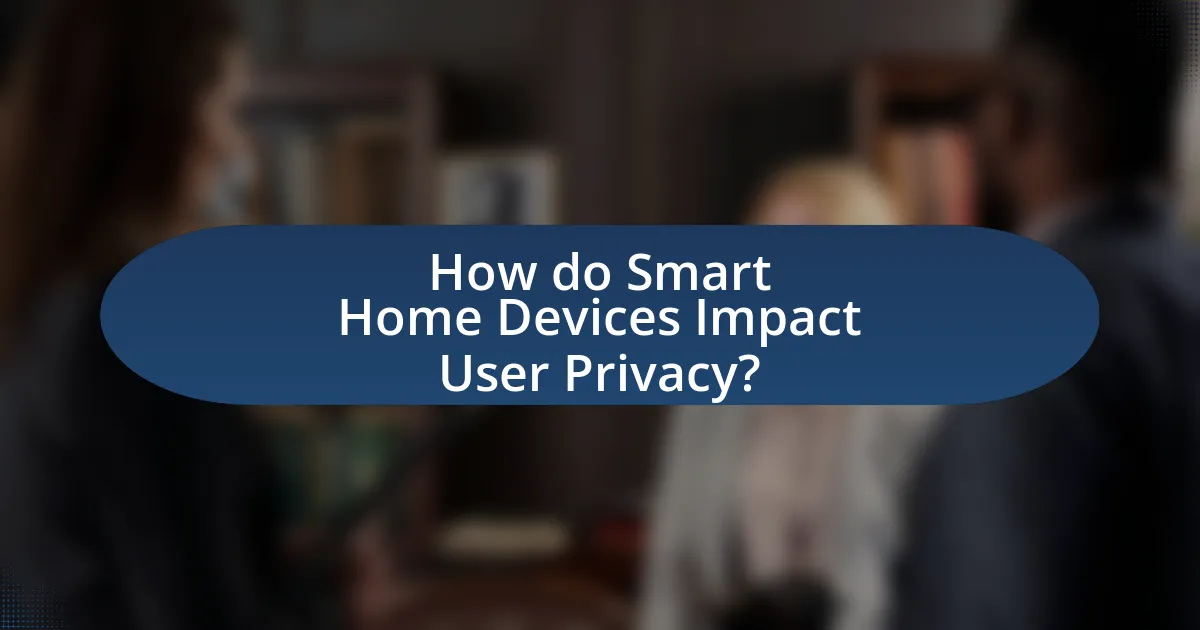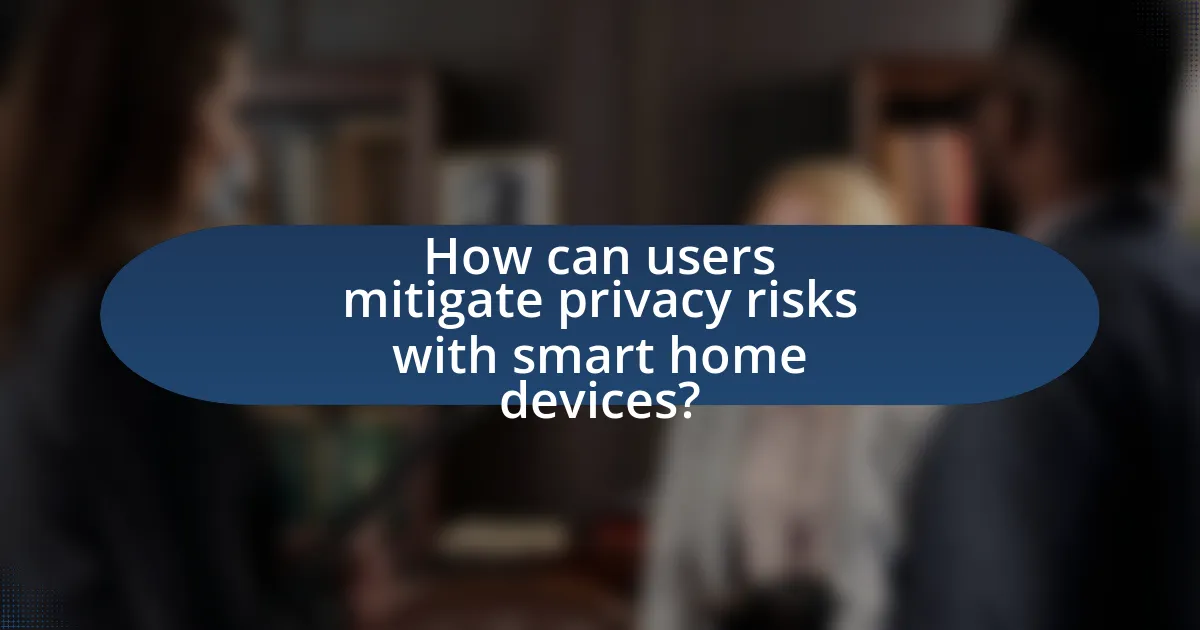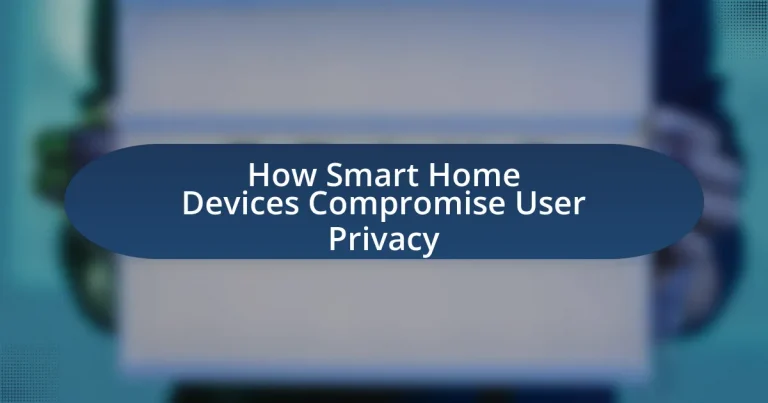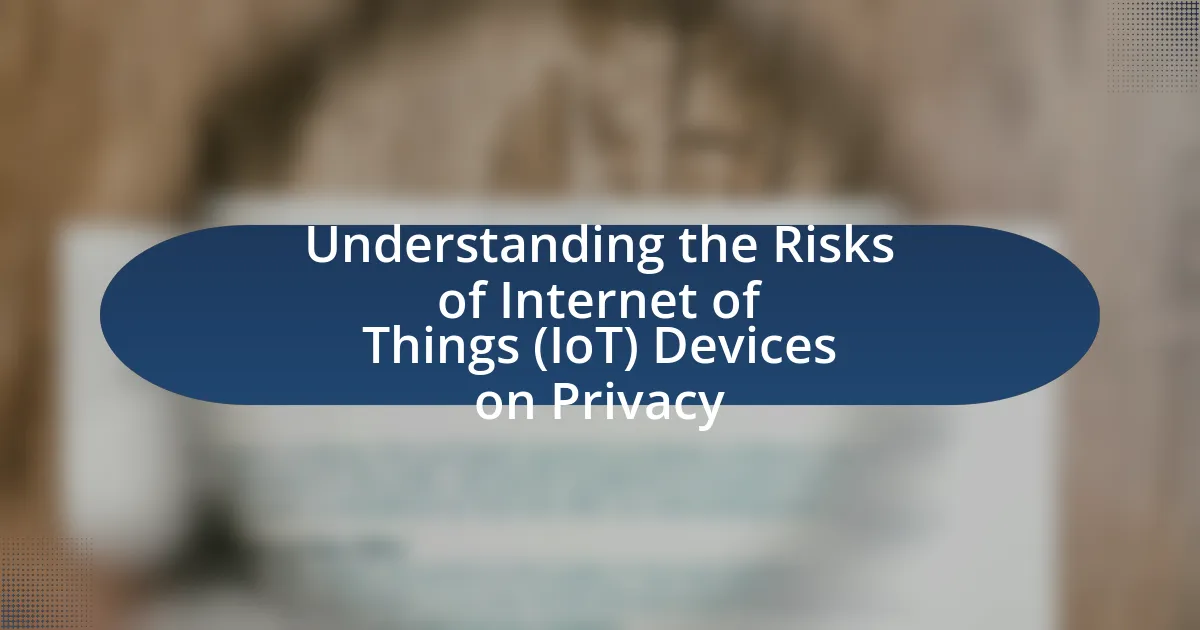Smart home devices, including smart speakers and security cameras, significantly impact user privacy by collecting extensive personal data that can be vulnerable to breaches and misuse. These devices gather various types of information, such as usage patterns, environmental conditions, and user interactions, often transmitting data to cloud servers where it may be accessed by third parties. Privacy concerns arise from inadequate security measures, complex privacy policies, and the potential for unauthorized access, leading to risks like identity theft and financial loss. Regulations like the General Data Protection Regulation (GDPR) and the California Consumer Privacy Act (CCPA) aim to protect user data, but users must also take proactive steps to mitigate privacy risks through strong security practices and awareness of data handling.

How do Smart Home Devices Impact User Privacy?
Smart home devices significantly impact user privacy by collecting vast amounts of personal data, which can be vulnerable to breaches and misuse. These devices, such as smart speakers and security cameras, often require constant internet connectivity and access to user information, including voice recordings, video feeds, and usage patterns. A study by the Electronic Frontier Foundation highlights that many smart home devices transmit data to cloud servers, where it can be accessed by third parties, increasing the risk of unauthorized surveillance and data exploitation. Furthermore, privacy policies are frequently complex and may not adequately inform users about data handling practices, leading to unintentional consent to data sharing.
What types of data do smart home devices collect?
Smart home devices collect various types of data, including usage patterns, environmental conditions, and user interactions. Usage patterns encompass information on how often devices are used and the specific functions activated, such as lighting schedules or thermostat settings. Environmental conditions include data on temperature, humidity, and air quality, which help devices optimize performance. User interactions involve voice commands, app usage, and preferences, allowing for personalized experiences. These data types are essential for improving device functionality and user convenience, but they also raise significant privacy concerns as they can be accessed and analyzed by manufacturers and third parties.
How is personal information gathered by these devices?
Personal information is gathered by smart home devices through various methods, including data collection via sensors, user interactions, and internet connectivity. These devices often utilize microphones, cameras, and environmental sensors to monitor user behavior and preferences, which are then transmitted to cloud servers for analysis. For example, smart speakers record voice commands and store them to improve functionality, while smart thermostats track temperature preferences to optimize energy use. This data collection can lead to the accumulation of detailed user profiles, which raises significant privacy concerns.
What specific user behaviors are monitored?
Smart home devices monitor specific user behaviors such as voice commands, device usage patterns, location data, and interaction frequency. These behaviors are tracked to enhance user experience, optimize device performance, and provide personalized services. For instance, smart speakers record voice commands to improve voice recognition algorithms, while smart thermostats analyze usage patterns to adjust heating and cooling efficiently. Additionally, location data is often collected to enable geofencing features, which can trigger actions based on the user’s presence or absence.
Why is user privacy a concern with smart home technology?
User privacy is a concern with smart home technology because these devices often collect, store, and transmit personal data, which can be vulnerable to unauthorized access. Smart home devices, such as cameras, voice assistants, and smart thermostats, continuously gather information about users’ habits, preferences, and daily routines. According to a 2020 report by the Electronic Frontier Foundation, many smart home devices lack adequate security measures, making them susceptible to hacking and data breaches. This exposure can lead to the misuse of personal information, identity theft, and unwanted surveillance, raising significant privacy issues for users.
What are the potential risks associated with data breaches?
Data breaches pose significant risks, including identity theft, financial loss, and reputational damage. Identity theft occurs when personal information is accessed and used without authorization, leading to fraudulent activities. Financial loss can result from unauthorized transactions or the costs associated with mitigating the breach, such as legal fees and credit monitoring services. Reputational damage affects businesses and individuals alike, as trust is eroded when sensitive data is compromised. According to the 2021 Cost of a Data Breach Report by IBM, the average cost of a data breach is $4.24 million, highlighting the financial implications of such incidents.
How can unauthorized access to smart home devices occur?
Unauthorized access to smart home devices can occur through various vulnerabilities, including weak passwords, outdated firmware, and unsecured networks. Weak passwords allow attackers to easily gain entry, as many users fail to implement strong, unique passwords. Outdated firmware can contain known security flaws that hackers exploit, while unsecured networks, such as those lacking encryption, enable unauthorized users to intercept data and control devices remotely. According to a 2021 report by the Cybersecurity & Infrastructure Security Agency, nearly 70% of smart home devices are susceptible to attacks due to these vulnerabilities, highlighting the critical need for robust security measures.
What regulations exist to protect user privacy in smart homes?
Regulations that protect user privacy in smart homes include the General Data Protection Regulation (GDPR) in the European Union and the California Consumer Privacy Act (CCPA) in the United States. The GDPR mandates that companies obtain explicit consent from users before collecting personal data and provides individuals with rights to access, rectify, and delete their data. The CCPA grants California residents the right to know what personal information is being collected, the right to delete that information, and the right to opt-out of the sale of their data. These regulations aim to enhance user control over personal information and ensure transparency in data handling practices.
How do laws like GDPR affect smart home device manufacturers?
Laws like GDPR impose strict data protection regulations on smart home device manufacturers, requiring them to ensure user consent for data collection and processing. Manufacturers must implement robust data security measures and provide transparency regarding how user data is utilized, stored, and shared. For instance, GDPR mandates that users have the right to access their data and request its deletion, compelling manufacturers to establish processes for compliance. Failure to adhere to these regulations can result in significant fines, with penalties reaching up to 4% of annual global turnover or €20 million, whichever is higher, as outlined in the GDPR framework.
What responsibilities do companies have regarding user data?
Companies have the responsibility to protect user data by ensuring its confidentiality, integrity, and availability. This includes implementing robust security measures to prevent unauthorized access and data breaches, as well as complying with relevant data protection regulations such as the General Data Protection Regulation (GDPR) in Europe, which mandates that companies must obtain explicit consent from users before collecting their data. Additionally, companies are required to provide transparency regarding how user data is collected, used, and shared, allowing users to make informed decisions about their privacy. Failure to adhere to these responsibilities can result in significant legal penalties and loss of consumer trust, as evidenced by the $5 billion fine imposed on Facebook by the Federal Trade Commission in 2019 for privacy violations.

How can users mitigate privacy risks with smart home devices?
Users can mitigate privacy risks with smart home devices by implementing strong security measures, such as changing default passwords and enabling two-factor authentication. Research indicates that 70% of smart device breaches occur due to weak or default passwords, highlighting the importance of creating unique, complex passwords for each device. Additionally, users should regularly update device firmware to patch vulnerabilities, as manufacturers often release updates to enhance security. Disabling unnecessary features, such as voice activation or remote access, can further reduce exposure to potential threats. Finally, users should review privacy settings and data-sharing permissions to limit the information shared with manufacturers and third parties, ensuring greater control over personal data.
What best practices should users follow to enhance privacy?
To enhance privacy, users should regularly update their smart home device firmware and software. Keeping devices updated ensures that security vulnerabilities are patched, reducing the risk of unauthorized access. According to a 2021 report by the Cybersecurity & Infrastructure Security Agency, outdated software is a common entry point for cyberattacks, highlighting the importance of timely updates. Additionally, users should enable two-factor authentication on their accounts, which adds an extra layer of security by requiring a second form of verification. This practice significantly decreases the likelihood of unauthorized access, as noted by the 2020 Verizon Data Breach Investigations Report, which found that 80% of data breaches could be prevented with two-factor authentication. Lastly, users should review and adjust privacy settings on their devices to limit data sharing, ensuring that only necessary information is collected and shared.
How can users secure their home networks against intrusions?
Users can secure their home networks against intrusions by implementing strong passwords, enabling network encryption, and regularly updating firmware. Strong passwords, which should be at least 12 characters long and include a mix of letters, numbers, and symbols, significantly reduce the risk of unauthorized access. Enabling WPA3 encryption on routers ensures that data transmitted over the network is secure. Regular firmware updates are crucial as they often contain security patches that protect against newly discovered vulnerabilities. According to the Cybersecurity & Infrastructure Security Agency, 85% of successful cyberattacks exploit known vulnerabilities, highlighting the importance of these security measures.
What settings should be adjusted on smart devices for better privacy?
To enhance privacy on smart devices, users should adjust settings related to data sharing, location services, and voice recognition. Specifically, disabling unnecessary data sharing with third-party applications limits exposure to personal information. Additionally, turning off location services prevents devices from tracking user movements, which is crucial for maintaining privacy. Furthermore, adjusting voice recognition settings to require explicit activation, such as a wake word, minimizes the risk of unintended recordings. These adjustments collectively reduce the likelihood of unauthorized access to personal data and enhance overall privacy.
What role does user awareness play in protecting privacy?
User awareness is crucial in protecting privacy as it empowers individuals to make informed decisions about their data and device usage. When users understand the implications of their interactions with smart home devices, they are more likely to implement privacy settings, recognize potential risks, and avoid sharing unnecessary personal information. Research indicates that a significant percentage of users are unaware of the data collection practices of their devices; for instance, a study by the Pew Research Center found that 81% of Americans feel they have little to no control over the data collected by companies. This lack of awareness can lead to increased vulnerability to privacy breaches. Therefore, enhancing user awareness through education and transparent communication about privacy practices can significantly mitigate risks associated with smart home devices.
How can users stay informed about privacy policies of devices?
Users can stay informed about privacy policies of devices by regularly reviewing the privacy settings and policies provided by manufacturers. Many companies publish their privacy policies on their official websites, detailing how user data is collected, used, and shared. Additionally, users can subscribe to updates from these companies or follow them on social media to receive notifications about any changes to their privacy practices. Research indicates that 79% of consumers are concerned about how their data is used, highlighting the importance of staying informed.
What resources are available for users to learn about privacy risks?
Users can learn about privacy risks through various resources, including government websites, academic research papers, and privacy advocacy organizations. For instance, the Federal Trade Commission (FTC) provides guidelines and reports on consumer privacy and data security, which are essential for understanding risks associated with smart home devices. Additionally, organizations like the Electronic Frontier Foundation (EFF) offer comprehensive resources and articles that explain privacy concerns and best practices for protecting personal information. Academic studies, such as those published in journals like “Privacy & Security” and “Journal of Cybersecurity,” also provide in-depth analyses of privacy risks related to technology, including smart home devices. These resources collectively equip users with the knowledge needed to navigate privacy challenges effectively.

What future trends may affect user privacy in smart homes?
Future trends that may affect user privacy in smart homes include increased integration of artificial intelligence, the rise of edge computing, and the implementation of stricter data regulations. The integration of AI in smart home devices can lead to more personalized experiences but also raises concerns about data collection and surveillance. Edge computing allows data processing closer to the source, which can enhance privacy by reducing the amount of data sent to the cloud, yet it may also create new vulnerabilities if not properly secured. Additionally, as governments worldwide implement stricter data protection laws, such as the General Data Protection Regulation (GDPR) in Europe, smart home manufacturers will need to adapt their practices, potentially impacting how user data is collected, stored, and shared. These trends collectively shape the landscape of user privacy in smart homes, highlighting the need for ongoing vigilance and adaptation by consumers and manufacturers alike.
How is technology evolving to address privacy concerns?
Technology is evolving to address privacy concerns through enhanced data encryption, user consent mechanisms, and the implementation of privacy-by-design principles. For instance, smart home devices now often utilize end-to-end encryption to secure user data during transmission, making it significantly harder for unauthorized parties to access sensitive information. Additionally, many devices are incorporating clearer user consent protocols, allowing individuals to have more control over what data is collected and how it is used. According to a 2022 report by the International Association of Privacy Professionals, 70% of consumers expressed a preference for devices that prioritize privacy features, indicating a market shift towards privacy-centric technology development.
What innovations are being developed to enhance data security?
Innovations being developed to enhance data security include advanced encryption techniques, artificial intelligence for threat detection, and blockchain technology for secure data transactions. Advanced encryption methods, such as homomorphic encryption, allow data to be processed without being decrypted, thus maintaining privacy. Artificial intelligence systems are increasingly used to identify and respond to security threats in real-time, significantly reducing response times to potential breaches. Additionally, blockchain technology provides a decentralized approach to data storage, making it more difficult for unauthorized users to access sensitive information. These innovations are crucial as they address the vulnerabilities associated with smart home devices, which often compromise user privacy by collecting and transmitting personal data.
How might user expectations shape future smart home devices?
User expectations will significantly shape future smart home devices by driving manufacturers to prioritize privacy and security features. As consumers increasingly demand transparency regarding data usage and protection, companies will be compelled to integrate advanced encryption, user-friendly privacy settings, and clear data policies into their devices. For instance, a survey by the Consumer Technology Association found that 70% of consumers are concerned about data privacy in smart home technology, indicating a strong market push for devices that address these concerns. Consequently, manufacturers that align their products with user expectations regarding privacy will likely gain a competitive advantage in the evolving smart home market.
What practical steps can users take today to protect their privacy?
Users can protect their privacy today by implementing strong password practices, such as using unique, complex passwords for each smart home device and enabling two-factor authentication where available. This approach significantly reduces the risk of unauthorized access, as studies show that 81% of data breaches are linked to weak or stolen passwords. Additionally, users should regularly update their device firmware to patch security vulnerabilities, as manufacturers often release updates to address potential threats. Furthermore, disabling unnecessary features, such as voice activation or camera access, can limit data collection and exposure. Lastly, users should review and adjust privacy settings on their devices to ensure minimal data sharing, as many smart home devices default to sharing more information than necessary.
How can regular software updates improve device security?
Regular software updates improve device security by patching vulnerabilities that could be exploited by cybercriminals. These updates often include fixes for known security flaws, which, if left unaddressed, can lead to unauthorized access or data breaches. For instance, a study by the Cybersecurity and Infrastructure Security Agency (CISA) found that 85% of successful cyberattacks exploit known vulnerabilities for which patches are available. By consistently applying updates, users can significantly reduce the risk of such attacks, thereby enhancing the overall security of their devices.
What are the benefits of using privacy-focused smart home products?
Privacy-focused smart home products enhance user security by minimizing data collection and protecting personal information. These products often utilize end-to-end encryption, ensuring that user data is not accessible to unauthorized parties. Additionally, they typically offer greater control over data sharing, allowing users to decide what information is shared and with whom. According to a study by the Electronic Frontier Foundation, privacy-centric devices significantly reduce the risk of data breaches and unauthorized surveillance, thereby fostering a safer home environment.





